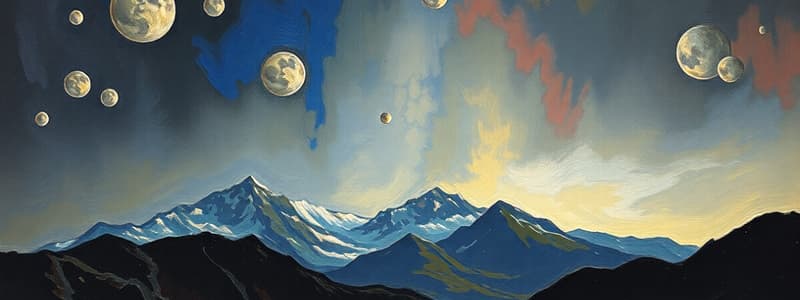Podcast
Questions and Answers
Explain the relationship between the lithosphere and the asthenosphere. What are the key differences that make up this relationship?
Explain the relationship between the lithosphere and the asthenosphere. What are the key differences that make up this relationship?
The lithosphere is the rigid, outermost layer of Earth, composed of the crust and upper mantle. The asthenosphere, located beneath the lithosphere, is a semi-molten, deformable layer of the upper mantle. The key difference is their rigidity: the lithosphere is rigid and brittle, while the asthenosphere is plastic and flows slowly. This difference in behavior allows tectonic plates, which are segments of the lithosphere, to move and interact with each other.
Describe the two main types of crust that make up the lithosphere and their key differences in composition.
Describe the two main types of crust that make up the lithosphere and their key differences in composition.
The two main types of crust are oceanic crust and continental crust. Oceanic crust is denser and thinner, primarily composed of basalt and gabbro with higher concentrations of magnesium and iron. Continental crust is less dense and thicker, primarily composed of granite and other felsic rocks with higher concentrations of silicon and aluminum.
Discuss the role of tectonic plates in shaping the Earth's surface. Provide examples of how this movement creates different landforms.
Discuss the role of tectonic plates in shaping the Earth's surface. Provide examples of how this movement creates different landforms.
Tectonic plates, segments of the lithosphere, interact at their boundaries, leading to various geological processes that sculpt the Earth's surface. Convergent boundaries where plates collide create mountain ranges, such as the Himalayas, and subduction zones, creating volcanic arcs and trenches. Divergent boundaries where plates move apart create mid-ocean ridges and rifts, leading to the formation of new oceanic crust. Transform boundaries, where plates slide past each other, create fault lines and earthquakes.
How does the composition and structure of the lithosphere impact the distribution of natural resources? Provide specific examples.
How does the composition and structure of the lithosphere impact the distribution of natural resources? Provide specific examples.
What is the significance of the lithosphere in understanding the Earth's climate system? Explain how this layer interacts with the atmosphere and hydrosphere.
What is the significance of the lithosphere in understanding the Earth's climate system? Explain how this layer interacts with the atmosphere and hydrosphere.
Flashcards
Lithosphere
Lithosphere
The rigid outer layer of the Earth, consisting of the crust and upper mantle.
Crust
Crust
The thin outer layer of the lithosphere, made of continental and oceanic plates.
Upper Mantle
Upper Mantle
The layer beneath the crust, part of the lithosphere, composed of solid rock.
Continental Plates
Continental Plates
Signup and view all the flashcards
Oceanic Plates
Oceanic Plates
Signup and view all the flashcards
Study Notes
Introduction
- The lithosphere is the rigid outermost shell of a terrestrial-type planet or moon, composed of the crust and upper mantle.
- It is typically about 100 km thick, but can vary considerably depending on location and tectonic activity.
- It is divided into tectonic plates that move and interact with each other.
Composition
- The lithosphere is primarily composed of silicate minerals, which are compounds of silicon and oxygen.
- These minerals form various rock types, including igneous, sedimentary, and metamorphic rocks.
- Common rock-forming minerals include quartz, feldspar, pyroxene, amphibole, and mica.
- The relative abundance and proportion of these minerals influence the physical and chemical properties of the lithosphere at a particular location.
- The precise composition varies regionally, reflecting the processes that formed the rocks.
Crustal Structure
- The crust is the outermost layer of the lithosphere, and it is further subdivided into:
- Oceanic crust: Primarily composed of basalt, a dark-colored volcanic rock, and is relatively thin.
- Continental crust: Primarily composed of granite, a light-colored igneous rock, and is significantly thicker than oceanic crust.
- The composition of the oceanic and continental crusts differs because of different formation processes and melting conditions.
- The continental crust is enriched in elements like aluminum and potassium relative to the oceanic crust.
Mantle Structure
- The mantle lies beneath the crust, extending to a depth of about 2,900 km.
- The mantle is primarily composed of silicate minerals, notably olivine and pyroxene.
- Its composition is typically less silica-rich compared to the crust.
- The mantle is divided into layers including the upper mantle, which includes the lithosphere, and a deeper, partially molten asthenosphere.
- The asthenosphere is ductile, allowing for plate movement.
- The lithospheric mantle is more rigid and is composed primarily of ultramafic rocks similar in composition to peridotite.
- Different types of peridotite are present, reflecting the varying chemical and physical regimes during formation.
- Transitions in mineral composition within the mantle contribute to varying seismic wave velocities.
Plate Tectonics
- The lithosphere is broken into numerous tectonic plates that float on and interact with the asthenosphere.
- Plate movement is driven by convection currents in the mantle.
- The boundaries of these plates are associated with significant geological activity, including earthquakes, volcanoes, and mountain building.
- Interactions like collisions, separations, and sliding of plates cause various geological formations.
Importance
- The lithosphere plays a crucial role in regulating the Earth's climate, supporting life through nutrient cycling and habitat provision, and providing resources.
- Its structure and composition influence the distribution of various minerals and resources.
- Interactions between the lithosphere, hydrosphere, biosphere, and atmosphere are critical to Earth's dynamic systems.
- The study of the lithosphere is vital to understanding Earth's history, processes, and future evolution.
Studying That Suits You
Use AI to generate personalized quizzes and flashcards to suit your learning preferences.




